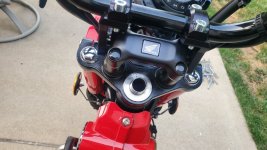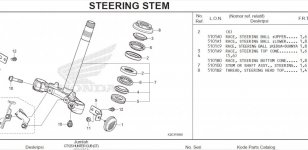The nut is: 53220-KE8-010 THREAD COMP., STEERING HEAD TOP
This tool says it's compatible with that part number:
https://www.honda-classics.co.uk/shop/Tool-Steering-Stem-Headrace-Nut-HWT005-p243207738
Should end up being under $40 USD shipped to the USA. I don't own it to confirm, but based on what the listing says it should work and save some $ for anyone considering buying the tool.
Or get yourself a big socket and an angle grinder.
I didn't end up getting this tool yet, but I did place the order so I'm waiting for it to arrive. In the meantime, I purchased some
pin spanners aka hook wrenches from Amazon ($49 for a 4 set; I have a need for all 4, but you only need 1 for this job, IIRC the smallest one),
a 1/2" driver torque wrench ($40) that could go to 88 Nm because I didn't have a torque wrench that goes that high, and
the only 29mm socket ($10) I could find on Amazon Prime was a 1/2" drive one. So I'm at $50 of necessary cost and **hand wavy** for the rest, either $40 or $89 depending on how you look at it.
I have the same problem with the “clunk” even when the suspension isn’t bottomed out. Done it since the day I got it and the dealer of course, is useless. I’ll probably try changing the fork oil out in case it was underserved. Have you made any more progress in figuring it out?
"Loose" is subjective to each person and their experiences. Mine is based off bicycles and bicycle headsets, which are extremally finicky for long term survival under incorrect tension if you're using a cup-and-cone instead of a sealed bearing system. The kind of finicky where 15 miles of riding on a Cane Creek headset would be enough to cause long term problems, and if you're kind of nervous about that you get used to bouncing the front wheel before you ride and being really cautious about excess play from an unexpected vibration on that bounce. I'm super, super sensitive to certain kinds of sensations because of this, one of them being loose headsets (which can be serviced mid-ride on a bicycle), so I'll say what I felt and what happened next.
When I was riding, especially over roadway that was in moderately good condition (occasional chunks taken out, cracked pavement, nothing major), I'd find that unloading the front end as I went over a slight bump would create this barely perceptible "wobble" in the steering that felt very familiar. For me, this is the exact same feeling I'd get from a bicycle headset that was going slightly out of spec, where once the load is removed slightly, the bearings aren't under enough compression to hold everything in place, and there'd be a very slight wobble in the handlebars due to it being out of tolerance. This, coupled with the clunk and the fact my bike just hit 10,000 mi made me think that there was a good chance the spec on the steerer was no longer in tolerance. In theory, the internets says you can pull on the forks and feel this out-of-tolerance movement somehow, but I tried that and I got absolutely nowhere with that test.
My point for following up on this was that last night, the 29mm socket arrived from Amazon.
- 6mm Hex key to undo the 4 bolts on the handlebar mount, torque spec 27 Nm (3-24 service manual, note tightening order), and the upper pinch bolts on the forks, torque spec 29 Nm. (3-22)
- 17mm socket to undo the fork caps, torque spec 22 Nm. (3-23)
- 29mm socket to undo the steering stem nut on the top, torque spec 88 Nm. (3-25)
- Ref: Steering Head Top Nut torque spec is to be initially tightened to 27 Nm. (3-25)
Officially what you're supposed to do is take that tool
@dmonkey linked to, remove the upper triple clamp, torque it to 22 Nm and then put everything back together again. Unofficially I took my hook wrench, lifted the clamp up 3/4 of the depth of the clamp, and very carefully tightened the steering stem headrace nut. I tightened it to what I thought was roughly the correct spec and checked for handlebar flop to either side.
My expectation was that the bearings should bind very, very slightly such that the wheel will not flop over immediately if you lift the front wheel off the ground by pressing the rear wheel down to the ground (sit on the rack), tilt the front wheel slightly to the side, and then bang the seat hard with your fist. Like a couple of good whacks, sure, but that first one shouldn't be enough, it should move slightly but not flop completely over to me. Before I started, having it slightly off to the side and doing the ol' seat whack while the wheel was in the air was enough to make it flop. I tightened it until I got to that point and called it good.
This morning I rode to work, trying to hit all the undulations that would normally unload the front to generate that wobble I was familiar with. No wobble. Then I hit a couple of manhole covers that were generating a clunk before. No clunk. Looks like the problem for me at least was the tolerance was out of spec.
EDIT:
Fork oil replacement for me was here if you're looking for my experience. Note the "new" parts that you're supposed to buy before you do the fork oil.





